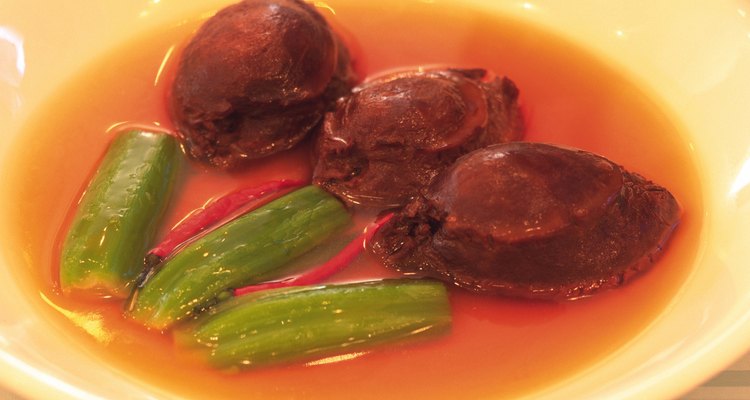
DAJ/amana images/Getty Images
Abalone possesses a mild, simple flavor, not unlike other mollusks, but its scarcity puts it in the upper echelon of exotic Asian foods. As with other Asian rarities, such as bird's nests and shark fins, abalones are in low supply and high demand, and command a lofty price. But despite their gourmet appeal, abalone is as easy to prepare as crabs, scallops and squid, and works in the same dishes.
Preparation
dried abalones need 24 to 36 hours of soaking in water to reconstitute. Scrub the flesh several times throughout soaking with a seafood brush and lemon juice to dislodge dirt and debris. Change the water every 12 hours. To prep fresh abalone, slice the flesh from the shell -- attached by the adductor muscle, or foot -- using a fillet knife. Slice away the head, entrails and gills from the flesh.
Marinating
Milk and acid marinades add taste and tenderness in different degrees. Use an acidic marinade -- 1 cup of olive oil to 1 tablespoon of vinegar or lemon juice and herbs and spices -- to impart flavor with a small dose of tenderization. Switch to a buttermilk marinade to add a slight tang while softening the muscle fibers to tenderness. Unlike most seafood, which lose texture and break down quickly in a marinade, you can marinate abalone as long as 12 hours without damage. Abalone steaks respond best to buttermilk marinades; sliced-and-tenderized abalone derives an abundance of flavor from acidic marinades.
Sauteed and Stir-Fried
Slice abalone about 1/4 inch thick and tenderize it using a meat mallet before marinating it or cooking it. Only strike the abalone hard enough to indent it without piercing it. Slice the pounded abalone into 1/4- to 1/2-inch-thick strips. Saute abalone on its own in vegetable oil over medium-high heat for 1 to 2 minutes. As part of a stir-fry, add sliced abalone in the last 2 to 3 minutes of cooking.
Braised
You get the best results from braising whole fresh or dried abalone, usually referred to as steaks. Packed with umami, supreme stock -- a mixture of chicken stock, pork broth and diced ham -- is the chief cooking liquid used in Chinese abalone dishes. Braise abalone as you would a tough cut of meat. You can use chicken stock, wine, tomatoes and any flavoring ingredients and spices you wish. Pour into a saucepan enough liquid to almost cover the abalone and braise it on the stove over medium heat or in a 300-degree Fahrenheit oven until tender. You can also substitute chopped abalone for clams in cream-based chowder recipes.
Steamed
Rice steamers turn abalone into an all-in-one meal when combined with rice, aromatics, stock and your vegetables of choice. For example, takikomi gohan with abalone -- a Japanese rice dish containing dashi, soy sauce, onions, carrots, mushrooms and thinly sliced abalone -- takes about 25 minutes in a rice cooker. Simply add all the ingredients and cook until the rice is finished. If you have a basket or bamboo steamer, you can steam abalone on its own for 25 to 30 minutes.
Abalone Patties
Finely mince abalone for an exotic take on classic crab cakes. Follow the basic crab-cake ratio -- 8 ounces minced abalone to 1 whole egg to 2/3 cup of panko breadcrumbs -- and add spices and seasoning to taste. When you add minced vegetables, such as spring onions, to the mix, adjust the consistency as needed with heavy cream or panko to bind it. Fry the patties in about 1/4 inch of vegetable oil for about 2 minutes on each side.
Related Articles
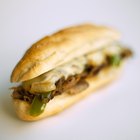
Leftover Filet Mignon Ideas

How to Boil Frozen Conch
How to Cook Dried Abalone

How to Cook Manioc Root
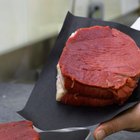
How to Slice Round Steak for Jerky

How to Cook Tripe
Homemade Cream of Mushroom Soup Recipe

How to Make Schmaltz Herring
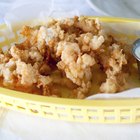
How to Cook Conch

Soaking Shrimp or Scallops in Lime Juice

How to Cook Fresh Jicama

How to Cook Couscous With Chicken Broth

How to Cook & Store Kombu

How to Cook Bear Steaks

How to Grill a Lamb Steak

How to Soak Porcini Mushrooms
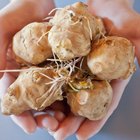
How to Cook Jerusalem Artichokes
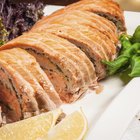
How to Cook Flounder Stuffed With Crab ...

How to Cook Moose Meat
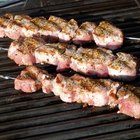
How to Cook Pork Loin
References
Writer Bio
A.J. Andrews' work has appeared in Food and Wine, Fricote and "BBC Good Food." He lives in Europe where he bakes with wild yeast, milks goats for cheese and prepares for the Court of Master Sommeliers level II exam. Andrews received formal training at Le Cordon Bleu.
Photo Credits
DAJ/amana images/Getty Images